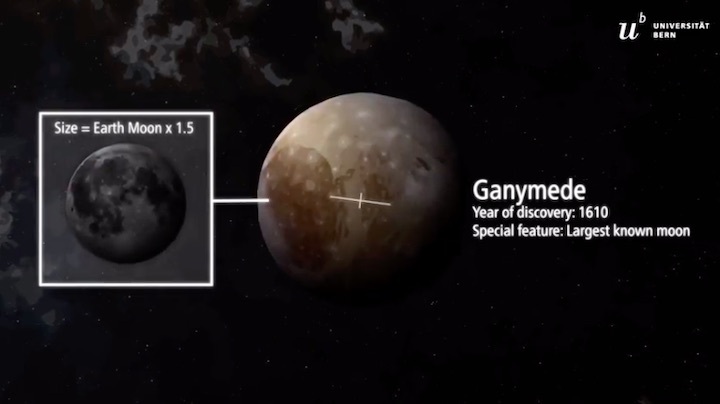30.05.2022
The JUICE space mission of the European Space Agency ESA is scheduled to fly to Jupiter in spring 2023 where it is to look for traces of life in three icy moons. The University of Bern is involved in this endeavor as well, amongst others with the NIM mass spectrometer, which is presented in a video.

In spring 2023, the time will have come: The JUICE (JUpiter ICy moons Explorer) space probe of the European Space Agency ESA will begin its journey into space. The Jupiter system is almost 780 million kilometers away from the sun and an icy, dark world: The average temperature on the surface of the icy moons is below minus 140 degrees Celsius. After an almost eight-year journey, JUICE will arrive at Jupiter to explore the largest planet in our solar system and three of its 79 moons. The icy moons are called Ganymede, Callisto and Europe.
Besides fundamental questions on the formation of planets and their moons, it is also a question of whether Europe and Ganymede are potential habitats, and in the best case, to identify signs of life. Data from earlier space missions and model calculations suggest that there are subterranean oceans far below the external ice layer of Ganymede and Europe. According to current knowledge, the oceans have all of the properties which are not only needed for the occurrence of life, but also which provide environments in which life can exist in the long term.
There will be eleven instruments on board of JUICE. One of them is the Neutral and Ion Mass Spectrometer (NIM), developed and built under the direction of Peter Wurz from the Physics Institute at the University of Bern.
More about the JUICE space mission and how the Bernese NIM mass spectrometer will help in the search for life can be seen in the following video, which was produced by the iLUB Support Center for ICT-Aided Teaching and Research in cooperation with the Space Research and Planetology division of the Physics Institute:
JOURNEY TO JUPITER WITH INVOLVEMENT FROM BERN
Besides the NIM mass spectrometer, two other instruments with participation from Bern will be on board of JUICE. On the one hand, the GALA laser altimeter, for which the ‘Range Finder Module’ was developed at the Physics Institute under the direction of Nicolas Thomas. GALA will investigate the topography of Ganymede. On the other hand, the Institute of Applied Physics under the direction of Axel Murk has developed the optics and the calibration unit for the Submillimeter Wave Instrument (SWI). The SWI will measure Jupiter’s stratosphere and the atmospheres and surfaces of Jupiter’s icy moons.
More information on the NIM: www.juice.space.unibe.ch
More information on the JUICE mission is available on the website of the European Space Agency ESA: www.sci.esa.int/web/juice
BERNESE SPACE EXPLORATION: WITH THE WORLD’S ELITE SINCE THE FIRST MOON LANDING
When Buzz Aldrin, the second man to step out of the lunar module, did so on July 21, 1969, the first thing he did was to unfurl the Bernese solar wind sail and plant it into the ground on the moon, even before the American flag. This experiment, which was planned, built and the results analyzed by Prof. Dr. Johannes Geiss and his team from the Physics Institute of the University of Bern, was the first great highlight in the history of Bernese space exploration.
The Bernese space exploration has been working with the world’s elite since then: The University of Bern regularly participates in space missions of major space organizations, such as ESA, NASA and JAXA. With CHEOPS, the University of Bern shares responsibility with the ESA for an entire mission. Moreover, the Bernese researchers are among the world leaders when it comes to models and simulations on the formation and development of planets.
The successful work of the Space Research and Planetology division (WP) of the Physics Institute of the University of Bern was consolidated by the foundation of a university competence center, the Center for Space and Habitability (CSH). The Swiss National Fund also awarded the University of Bern the national research focus (NFS) PlanetS, which it manages together with the University of Geneva.
